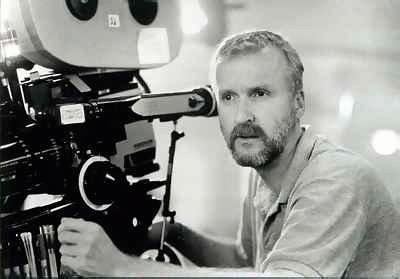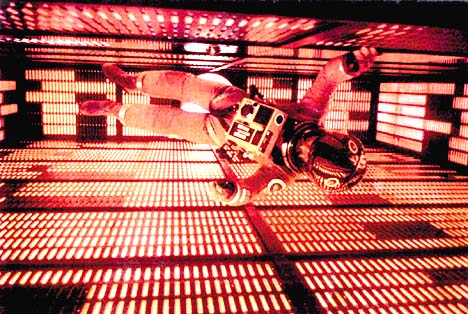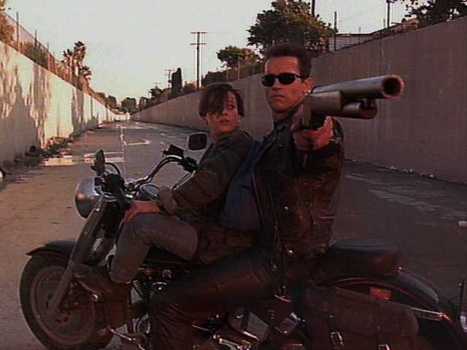With the highly anticipated film Avatar releasing later this year, James Cameron has re-entered into the spotlight. Cameron has been considered one of the greatest filmmakers of our generation with blockbuster and critical acclaimed films like Terminator 2, Aliens, and Titanic. So we thought it would be interesting to learn about the man behind the camera.
This interview is an abridged version from Flimmaker.com. The link to the full interview is below.
James Cameron was born in Kapuskasing, Ontario, Canada in 1954 but grew up in Chippawa, a small town just outside of Niagara Falls, Ontario, where demanding, disciplinarian parents, with whom he developed the creative energy and tireless work ethic, raised him. His father Phillip Cameron, was an electrical engineer and his mother, Shirley Cameron was an artist. She encouraged her son to paint, and even helped arrange an exhibition for him at a local gallery.
The young natural leader organized his playmates in such adventurous endeavors as building a functional catapult that pitched boulders large enough to make impact craters; on another occasion, he and his cohorts created a miniature diving vessel to send mice to the bottom of Niagara River.
Not only did Cameron desperately try to understand how motion pictures were made but also he wrote sci-fi stories and fantasized a lot instead of doing his homework. It was actually during a biology class in high school that Cameron wrote a short story, which would later become the movie, The Abyss.
The next pivotal juncture in Cameron’s evolution as a filmmaker came in 1977, when he saw Star Wars for the first time. It was exactly the movie he had dreamed of making since watching 2001: A Space Odyssey, and it inspired him to finally reach out for the dream.
It occurred to him that the possibility of integrating his interests in science and art were possible, due to the book Screenplay, which encouraged himself and two friends to create a ten minute script together. They raised the money to shoot it in 35mm and rented a camera, lenses, the film stocks and a studio. To understand how to operate the camera they simply dismantled it and spent the first half-day of the shoot just trying to figure out how to get it running.
When it came to the special effects area, Cameron explains that he was “completely self taught in special effects. I’d go down to the USC library and pull any theses that graduate students had written about optical printing, or front screen projection, or dye transfers, anything that related to film technology…if they’d let me photocopy it, I would. If not, I’d make notes.”
As the future filmmaker continued to educate himself in the techniques, he landed a job as a miniature model maker at the Roger Corman Studios. Making fast, low-budget productions, Cameron was able to pick up the pace efficiently and effectively, moving up his ranking within the studio, soon working as an art director in the sci-fi movie Battle Beyond the Stars (1980), and he did special effects work design and direction on John Carpenter’s Escape from New York (1981).
Cameron finally got his big break in 1981 when he got his first shot at directing a film entitled Piranha II: The Spawning. Italian producer Assonitis, was determined to produce a sequel to the original Piranha film. In an effort to save money and have complete control over the film’s direction, the inexperienced Cameron was chosen. However, Assonitis and Cameron just ended up butting heads by the time the movie’s release came around.
The movie was to be produced on Jamaica but when Cameron arrived at the studio, he discovered that his crew was comprised primarily of Italians who spoke no English and that the project was under financed.
The movie of course was terrible. After being given the red light by Assonitis for editing the disaster flick, Cameron desiring to edit his own flawed masterpiece broke into the editing room with a plastic credit card. He taught himself to use the unfamiliar Italian editing equipment and secretly re-cut the entire movie.
Assonitis continued to pester Cameron about the lousy shooting and editing. Cameron, under duress, in a feverish comatose stage, had a nightmare about an invisible robot hit man sent from the future to kill him. So he started to work on the project and his nightmare bloomed into the script, which would catapult his filming career: The Terminator (1984).
While waiting for Terminator to be financed, Cameron accepted two writing jobs. Cameron worked on the screenplay of Rambo: First Blood Part 2 (1985) with Sylvester Stallone and Aliens (1986), the sequel to the 1979 science fiction classic Alien.
Cameron was positive that the dream he had earlier had potential, so he contacted action producer Gale Anne Hurd. He sold her the script for one dollar, on condition he be allowed to direct the movie and direct it his way. The result was a low-budget movie, made on a mind-bogglingly minimal budget of $6.5, which became a huge success.
The Terminator received international acclaim and recognition appearing in Time magazine’s Top Ten best list, grossing over $80 million worldwide. This movie did not only score a huge financial victory and firmly established Cameron’s reputation as both a screenwriter and director of undeniable talent, but it launched Arnold Schwarzenegger’s career as well.
After The Terminator Cameron was asked to direct the second Aliens movie of which he had already written the script in a three-month period. Cameron demanded that Gale Anne Hurd be brought on board as a producer. Before shooting Aliens James Cameron and Gale Anne Hurd became involved both professionally and romantically and after a short courtship were wed.
The movie, Aliens was well received by the audience and critics alike with its riveting special effects, a well-written script, and an Oscar worthy performance from Sigourney Weaver. The movie received seven Academy Award nominations, winning the Oscar for Best Visual Effects and Best Sound Effects. The film became the most successful R-rated film ever, grossing approximately $180 million worldwide. Rambo 2 grossed over $250 million globally, making it an international mega-hit.
A buzz began to circulate around Hollywood concerning this up and coming director. Everybody who was anybody wanted to befriend and work alongside Cameron on his next project. However, instead of settling for the all mighty dollar deals to direct other people’s stories, Cameron decided to put all of his talents into his own work, The Abyss (1989) was born.
The Abyss would later set new standards for underwater shooting. The crew along with Cameron had to design and create most of the gear worn by the actors, which was no small feat. Furthermore, the entire movie was exhaustinglytime-consuming and expensive and post-production ended up delayed because of some of the difficult effects shots that were to be in the movie, which were later edited out. The film took 18 months to complete.
The movie received four Academy Award nominations, winning an Oscar for the Best Visual Effects and grossing $110 million worldwide. Even though Cameron was getting the opportunity to excel even further professionally, his personal life was yet again paying the price. Cameron and Gale Anne Hurd were departing ways during the production and ended up divorcing right after the movie was finished.
Cameron went on to produce the very successful movie and now TBS “Movies for Guys who like movies” classic, Point Break (1991). Kathryn Bigelow, whom Cameron married that very same year the movie was released, directed the movie. Point Break made over $100 million worldwide and topped the video rental charts for five weeks straight.
His involvement with Point Break give birth to the famous morphing effect Cameron would use to create the liquid metal T-1000 for his next mega project, the hugely profitable Terminator 2: Judgment Day. Cameron capitalized on the success of T-1000 by launching his own special effects company, Digital Domain, in collaboration with effects wizard Stan Winston and corporate giant IBM.
Terminator 2: Judgment Day budget spiraled out of control and became the most expensive movie of all time but it was also the most profitable movie James Cameron has worked on, grossing $500 million. During this time he divorced his wife Kathryn Bigelow and got hooked up with Linda Hamilton, the female star from the terminator-movies. He also formed his own production company, Lightstorm Entertainment, and inked an exclusive deal with Fox to finance his next three movies but he exceeded the limit of Fox’s funding on each of his next two-films.
“T2″ received six Academy Award nominations, bringing home four in Best Makeup, Sound, Visual Effect
and Sound Effects Editing. It also received the Ray Bradbury Award for Dramatic Screenwriting, five Saturn Awards from the Academy of Science Fiction, six MTV Movie Awards, and the People’s Choice Award.
As a result of their union, Linda Hamilton gave birth to a baby girl, Josephine Archer in 1984. During this time period Cameron wrote, produced and directed the action-comedy True Lies, America’s version of the James Bond icon, which grossed a cool $365 million in worldwide box office. The following year, while he was in pre-production of his next movie, Titanic, Lightstorm Entertainment presented Strange Days, directed by Kathryn Bigelow from a screenplay by James Cameron and Jay Cocks. Unfortunately, it didn’t become the great success it deserved.
The most recognizable and successful piece of film work Cameron has ever worked on is the retold story of Titanic. Cameron spent most of his time at the bottom of the Atlantic to see the Titanic’s wreckage, visiting it a total of twelve times.
“It was sort of like going to Mecca first, and getting religion. We went there with very specific objectives, and I took two things away from the experience,” explained Cameron, “Working around the wreck for so much time, you get such a strong sense of the profound sadness and injustice of it, and the message of it. You think ‘There probably aren’t going to be many filmmakers who go to Titanic. There may never be another one-maybe a documentarian.’ So it sort of becomes a great mantle of responsibility to convey the emotional message of it-to do that part of it right, too.”
Taking charge of the responsibility, Cameron cast a spectacular cast; many of their features resembled the real life crew. Leonardo DiCaprio and Kate Winslet were cast as the leading roles, which the story plot revolved around the love of the two.
Cameron served as director, producer, and editor on the film and due to the film’s production, $200 million, tremendously exceeding its budget; Cameron forfeited his fees except the $1.5 million received for the screenplay. Titanic opened in the US on December 19, 1997 and took in approximately $25.5 million in its first weekend. The movie quickly replaced George Lucas’s Star Wars as the top-grossing film of all time, grossing more than a billion dollars worldwide. Furthermore the movie later won eleven Oscars tying it with the unforgettable movie Ben Hurr. , It won Oscars for Best Picture and Best Director. Cameron truly became “King of the World.”
When asked about becoming a film director by inspiring directors, Cameron is prepared. “I tell them that no two people will ever do it the same way, and there is nothing I can say that will help you. Whatever your talents are, whatever your strengths and weaknesses, you have to find the path that’s going to work for you. The film industry is about saying ‘no’ to people, and inherently you cannot take ‘no’ for an answer.”
He has written the screenplay of Spider-Man and is working on Avatar, a science-fiction film that will revolutionize filmmaking. He plans to cast with non-human, digitally generated actors. Even though James Cameron has been nominated for and won countless awards he still strives to be a director truly committed to his work as only a perfectionist could. Perhaps that is the reason why he is so renowned globally for he can create new genres of films and stretch our imagination to places where we have never gone before.
This interview is an abridged version from Filmmaker.com.









hari prasath
July 31, 2010
Every Man should have aim,,
” i think cameron have thinking about to fills his room with AWARDS……
Tony
July 31, 2010
He’s prob going to need a bigger room! Thx for visiting & commenting!
Motea Ion
October 23, 2010
Esti cel mai bun regizor al tuturor timpurilor si asa miasi dori sa fiu si eu
Arselio
February 26, 2011
Dear Dir. James Cameron,
I want to be an Actor. I am cute, good and emotional guy. I am good in acting particularly in drama and action. I have no fear in stunts and i have 3d characters looks, these are Bumblebee, Hulk, Chucky, Predators and Terry in Batman Beyond.
This is my video: http://www.youtube.com/watch?v=fyjk8lRSv1o
My email is sed_dream@yahoo.com
Thanks,
Arselio
shubhkaran
March 2, 2011
well i will become like him someday………